How To Write A Product Description: A Step-by-Step Guide & Examples

A compelling product description is the cornerstone of any successful ecommerce business. It’s more than just a list of features; it’s a persuasive sales tool that transforms browsers into buyers.
In today's competitive marketplace, a well-crafted product description can significantly impact your conversion rates and set your brand apart from the competition. Whether you’re selling handcrafted jewelry, cutting-edge electronics, or everyday essentials, mastering the art of product descriptions is essential for engaging your audience and driving sales.
In this guide, we will explore the key elements of effective product descriptions, provide practical tips for writing compelling content, and share examples that illustrate best practices.
What Is A Product Description?
A product description is a comprehensive overview of a product, detailing its features, benefits, and unique value proposition. It accompanies a product image on an online store or marketplace, providing essential information that helps potential customers make informed purchasing decisions.
While product features outline the specifications and capabilities of the item, a product description should emphasize how these features translate into tangible benefits for the customer, addressing their needs and solving their problems. For content creators, a compelling product description is crucial as it not only differentiates their products from competitors but also enhances the customer experience by offering clear, engaging, and persuasive content.
The Importance Of A Good Product Description
Effective product descriptions are essential for driving sales and building a strong brand. They influence several key factors:
Increased Conversion Rates
When descriptions are detailed and persuasive, they provide potential buyers with the information and reassurance they need to feel confident in their decision. By addressing customer concerns, highlighting benefits, and showcasing unique features, these descriptions create a compelling narrative that encourages customers to complete their purchases, ultimately leading to higher sales and improved customer satisfaction.
Improved Search Engine Rankings (SEO)
Search engine rankings (SEO) are achieved by incorporating relevant keywords throughout your product descriptions, which helps search engines better understand the content and context of your products. This strategic use of keywords leads to higher visibility in search results, making it easier for potential customers to discover your offerings.
Enhanced Brand Image
When customers encounter well-written and informative descriptions, they perceive your brand as professional and reliable, which builds their trust. This positive perception can lead to increased customer loyalty, as shoppers are more likely to return to a brand that consistently meets their expectations and provides a great shopping experience.
Reduced Return Rates
A clear and accurate product description can effectively manage customer expectations and directly benefit reduced return rates. When potential buyers have a thorough understanding of the product's features, specifications, and intended use, they are less likely to experience disappointment upon delivery, which is a common reason for returns.
Increased Customer Satisfaction
When customers are given detailed descriptions of a product's specs and features, customers can confidently assess whether it meets their needs and preferences. This transparency not only reduces the chances of post-purchase regret but also fosters a sense of trust in your brand, encouraging repeat business and positive word-of-mouth referrals.
How To Write A Product Description in 12 Steps
Step 1: Know Your Target Audience
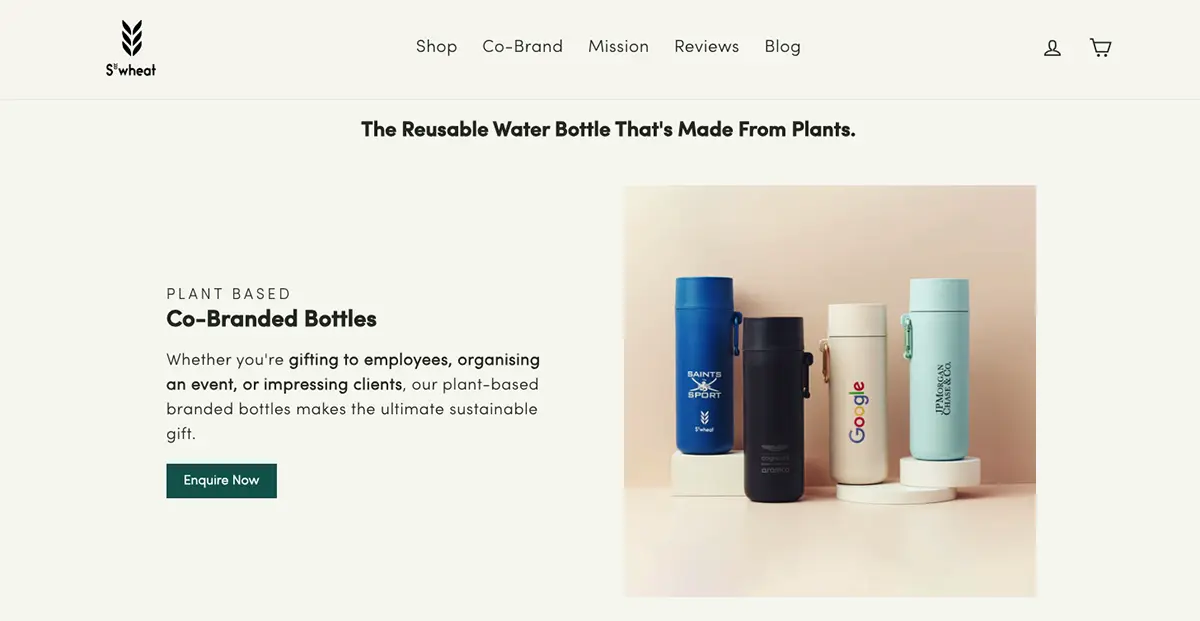
Crafting effective product descriptions that resonate and persuade starts with understanding your target audience.
Begin by creating a detailed buyer persona that outlines the demographics, interests, pain points, and buying behavior of your target customers. This persona will help you pinpoint what your shoppers value most and what specific problems they need solving.
For instance, if you are selling eco-friendly water bottles, your target customers might value sustainability and want a product that makes their lives better by reducing plastic waste.
Tailoring your product description to address these concerns, such as highlighting how the product is made from recycled materials and its long-term environmental benefits, aligns with their values and addresses their pain points.
2. Focus on Benefits, Not Just Features
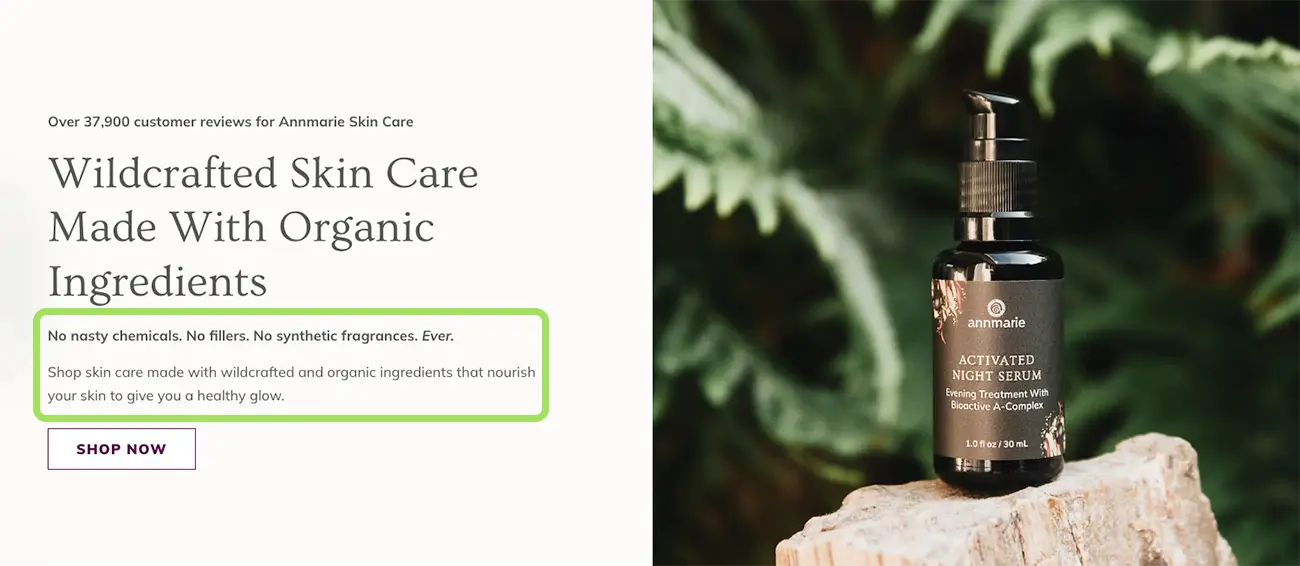
Focusing on a product’s benefits rather than relying solely on its features is essential in effective description writing. While highlighting attention-grabbing features like "vegan ingredients" or "cruelty-free" can attract customers, it's even more impactful to explain how these features enhance their lives.
For example, instead of simply stating that a beauty product is vegan-friendly, a compelling description could emphasize that it contains nourishing plant-based ingredients that hydrate and revitalize the skin without harmful chemicals, making it an ideal choice for conscious consumers who care about their health and the environment.
Description examples that emphasize benefits might say, "This vegan-friendly moisturizer is packed with natural oils and botanical extracts that provide deep hydration and promote a radiant complexion, ensuring your skin feels soft and looks glowing all day long."
By focusing on how the product solves a problem, fulfills a desire, or improves the customer's life, you create a persuasive and engaging narrative that resonates with your target audience and drives sales.
3. Use Engaging and Persuasive Language

Using engaging and persuasive language in your product description can significantly enhance its appeal and effectiveness. Incorporate active verbs, descriptive adjectives, and sensory words like "soft," "vibrant," and "luxurious" to create a vivid picture of the product.
Power words such as "exclusive," "premium," and "essential" can also help persuade potential customers by highlighting the product's unique qualities.
For example, instead of a simple product description that states, "This shirt is made of organic cotton," you might write, "Experience the ultimate in comfort and sustainability with our organic cotton shirt, crafted from the softest, breathable fabric that feels gentle against your skin and helps you stay cool all day long."
Emphasizing the sensory experience and the unique benefits of the product creates a compelling narrative that resonates with potential customers, making them more likely to choose your product over others.
4. Tell a Story
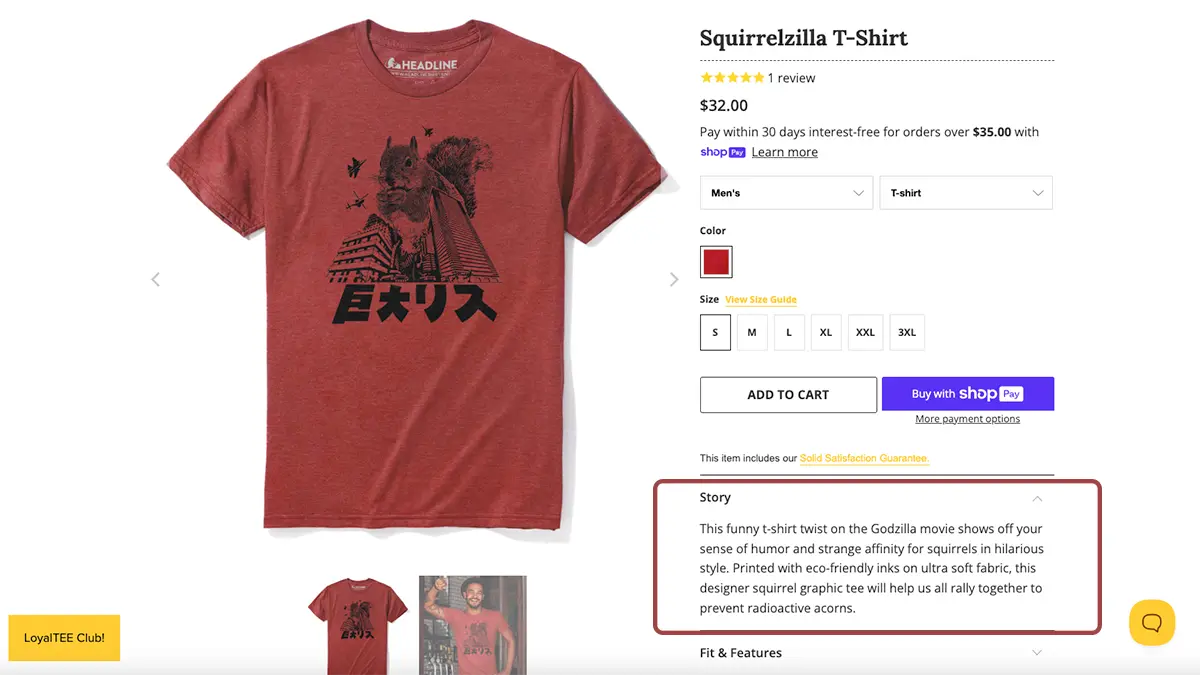
Incorporating storytelling elements into your product description can make it more relatable and memorable. A short paragraph that tells a compelling story about how the product can enhance the customer's life can transform a list of product features into a persuasive narrative.
For example, if a shirt has a cool or funny design on it, briefly talk about what inspired you to make that design. Perhaps it was a humorous moment shared with friends that sparked creativity or a quirky phrase that reflects a shared experience in everyday life.
Imagine saying, “This shirt features a playful design inspired by late-night brainstorming sessions with friends, where we dreamed up the perfect way to express our love for adventure and laughter. Every time you wear it, you’ll carry a piece of that joyful spirit with you, sparking conversations and smiles wherever you go.”
By sharing this story, you not only highlight the product's design but also create an emotional connection. Potential shoppers can envision themselves wearing it in their own lives and making their own memories. This engaging narrative can inspire them to make a purchase, making them feel as though they are part of a larger story and community.
5. Keep It Clear and Concise
Keeping your product descriptions clear and concise is vital for effectively engaging potential customers. By avoiding jargon and overly complex language, you ensure that your audience can quickly grasp the key benefits of your products without feeling confused or overwhelmed.
For example, if you’re selling a kitchen blender, instead of saying, "This appliance features a powerful motor that efficiently pulverizes ingredients," you could simplify it to "Blend smoothies and soups effortlessly with our powerful kitchen blender." This approach not only enhances readability but also caters to a broader audience, including those who may not be familiar with technical terms.
Remember, breaking up your product's description into concise sentences and short paragraphs makes your content more appealing and easier for shoppers to digest.
6. Highlight Unique Selling Points (USPs)
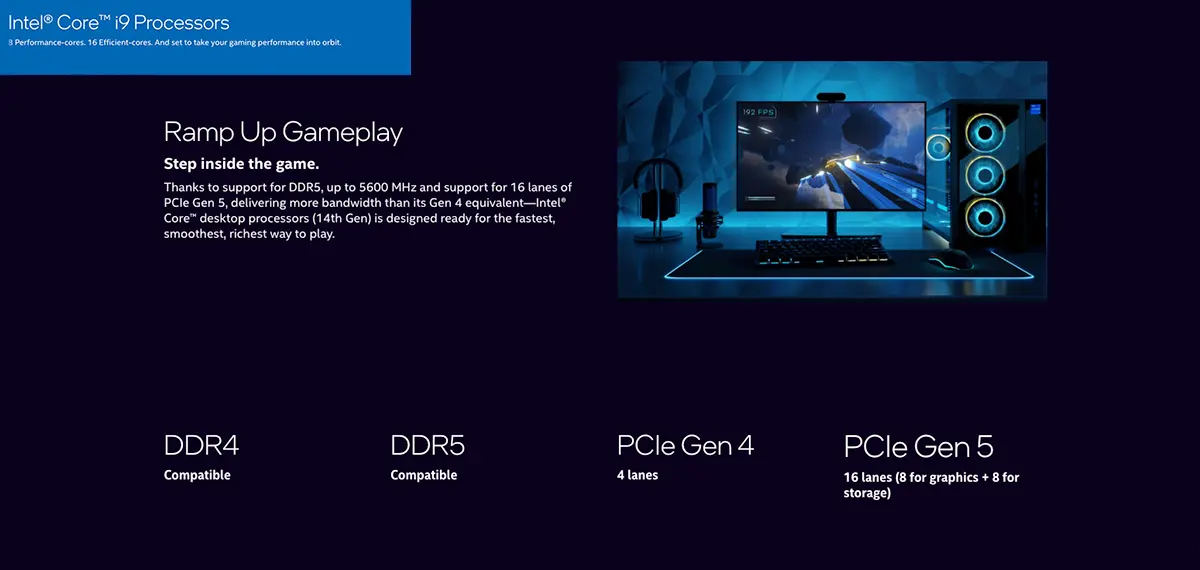
Identifying and emphasizing your product's Unique Selling Points (USPs) is essential for standing out in a competitive market. USPs can encompass unique features, superior quality, or exclusive benefits that resonate with your target audience.
For example, if you’re marketing a high-performance gaming laptop, you could highlight its distinct attributes, such as having a cutting-edge graphics card for superior visual quality, customizable RGB keyboard lighting, and an ultra-fast refresh rate for seamless gameplay.
By stating, "Our gaming laptop features an advanced graphics card that delivers stunning visuals and a 144Hz refresh rate for fluid, lag-free gaming," you effectively showcase the product’s unique qualities.
This clear presentation of USPs not only grabs attention but also addresses potential customers' concerns and desires, helping them understand why your product is the ideal choice.
7. Use Bullet Points for Easy Reading
Incorporating bullet points into your product description is an effective strategy for enhancing readability and ensuring that key features and benefits are easily scannable.
A bulleted list allows potential customers to quickly identify the most important aspects of your product without wading through dense paragraphs.
For example, if you're selling a high-performance backpack, you could structure the product description like this: Key Features Include:
- “Water-resistant material for durability.”
- “Ergonomic design for comfort.”
- “Multiple compartments for organization.”
- “Lightweight construction for easy carrying."
This clear presentation makes it simple for customers to absorb information at a glance, increasing the likelihood that they'll engage with the content and consider making a purchase.
Moreover, using bullet points can also improve your SEO, as search engines often favor scannable content that provides clear and concise information.
8. Include Social Proof
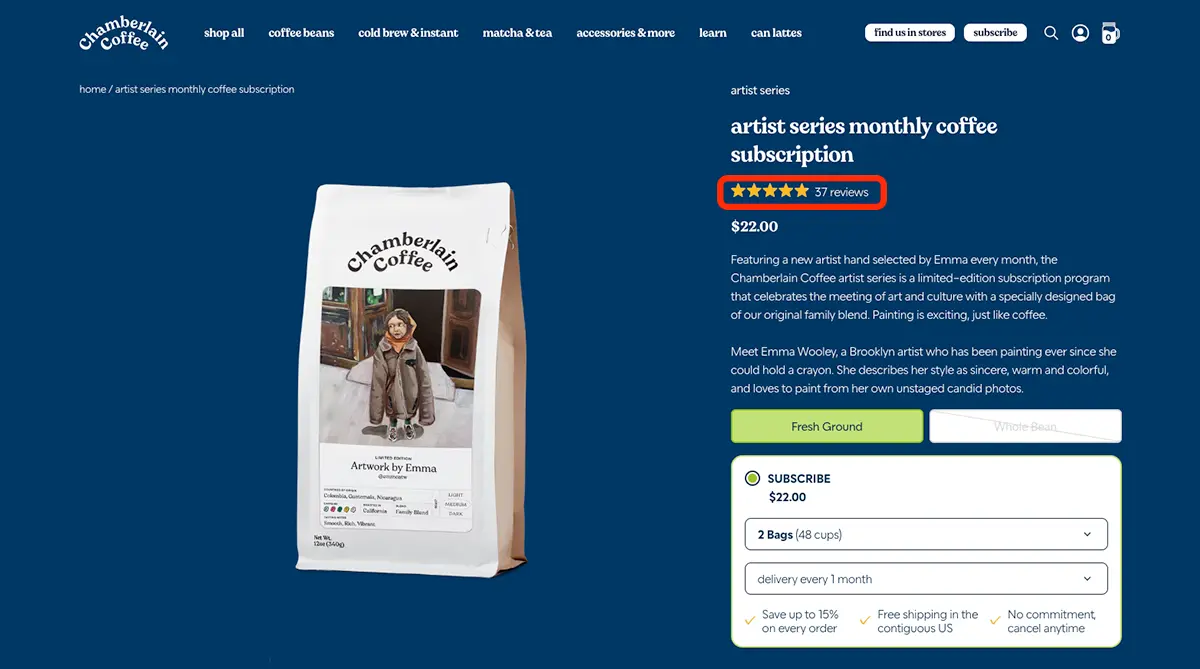
In today’s digital landscape, where consumers are increasingly influenced by the opinions of others, leveraging social proof can significantly impact your conversion rates and overall success.
Customer reviews, testimonials, and ratings serve as endorsements that reassure prospects about the product's quality and reliability.
For example, Chamberlain Coffee showcases reviews and ratings for each of its products on its website, providing potential buyers with insights from fellow coffee enthusiasts.
Each product page features user reviews, such as "This coffee is rich and smooth—my new morning favorite!" along with an average star rating, which instills confidence in the quality of the offerings.
This strategy not only highlights the positive experiences of past customers but also provides tangible evidence that the products deliver on their promises.
9. Optimize for SEO
Optimizing your product descriptions for SEO is essential for improving your visibility on search engines and driving organic traffic to your ecommerce site. Start by researching relevant keywords that your target audience is likely to use when searching for your products.
For example, if you’re selling a yoga mat, keywords such as "non-slip yoga mat," "eco-friendly fitness gear," or "durable exercise mat" should be incorporated naturally into your product description.
Use these keywords strategically in the title, headings, and throughout the text to enhance SEO without compromising the flow of the description. For instance, a title like "Eco-Friendly Non-Slip Yoga Mat for Ultimate Comfort" includes important keywords while clearly describing the product.
Additionally, using description examples that highlight the mat's benefits and features—like "Perfect for all levels, our non-slip yoga mat ensures stability during your practice"—can further improve your ranking.
By prioritizing SEO in your product descriptions, you not only increase the likelihood of appearing in search results but also attract more qualified leads who are actively looking for products like yours, ultimately boosting sales and brand awareness.
10. Incorporate a Call to Action (CTA)
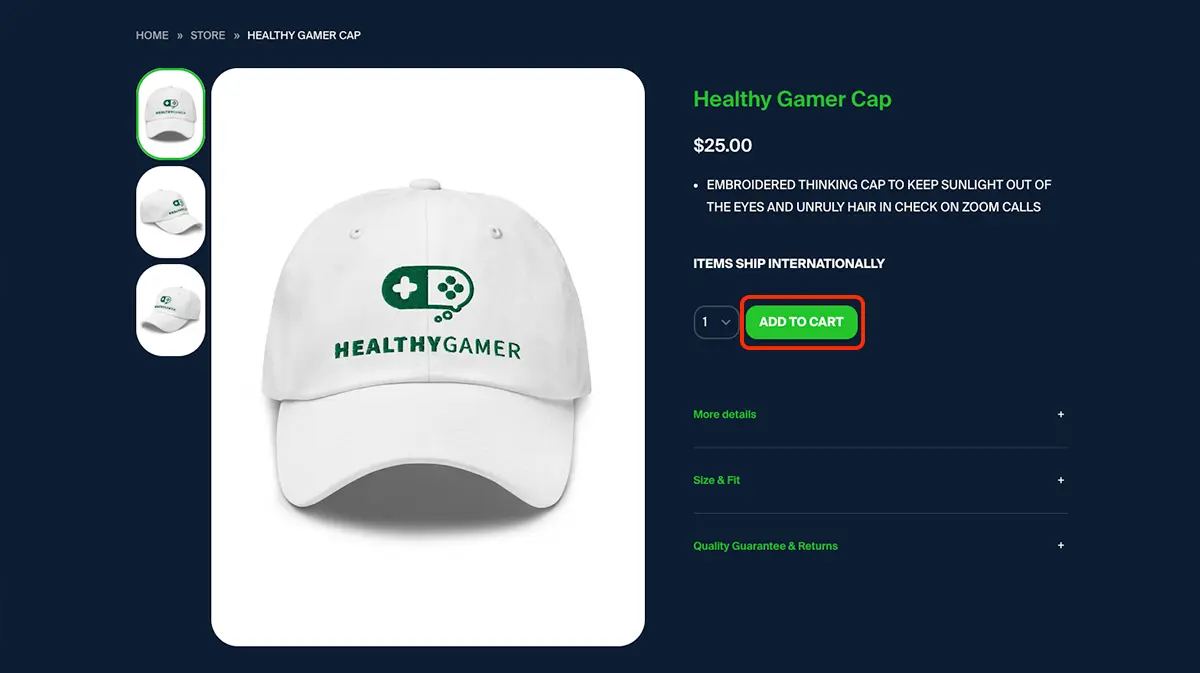
Incorporating a strong Call to Action (CTA) at the end of your product description is essential for guiding potential buyers toward the next step in their purchasing journey. Words like "Shop Now," "Add to Cart," or "Discover More" create a sense of urgency and encourage immediate action.
For instance, after describing the features and benefits of a stylish handbag, you could conclude with a compelling CTA such as, "Don't miss out on this must-have accessory—add it to your cart today and elevate your style!"
Using power words such as "exclusive offer," "limited time," or "transform," can evoke emotion and strengthen the impact of your Call to Action (CTA). These words create a sense of urgency and excitement, encouraging customers to take immediate action.
Additionally, making your product description visually appealing by incorporating plenty of white space helps your CTA stand out, making it easier for customers to notice your content and engage with it.
11. Provide Detailed Specifications
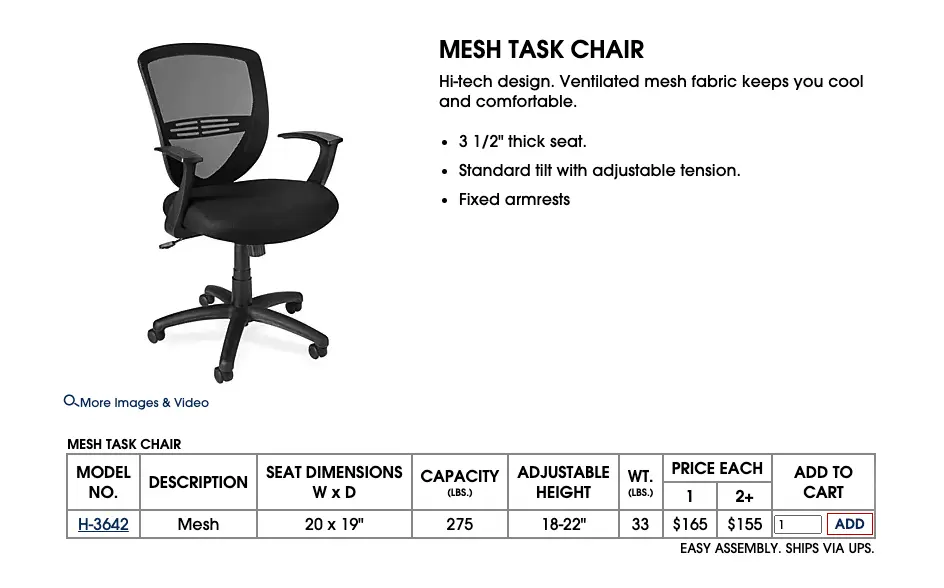
Including detailed specifications in your product descriptions is crucial for helping customers make informed purchasing decisions. Providing essential technical details such as dimensions, materials, weight, and care instructions not only informs customers but also builds trust in your brand.
For example, if you're selling a premium office chair, you might include specifications like "Dimensions: 24 x 25 x 40 inches; Material: High-density foam with a breathable mesh back; Weight capacity: 300 pounds."
This level of detail allows potential buyers to envision how the chair will fit into their workspace and ensures they are aware of its features before making a commitment. Considering information about warranty and care guidelines can further assist customers in understanding the product's longevity and maintenance needs.
By offering comprehensive specifications, you reduce the likelihood of returns due to unmet expectations, enhance customer satisfaction, and ultimately contribute to a positive shopping experience.
12. Proofread and Edit
Proofreading and editing your product description is essential for presenting a professional and trustworthy image to potential customers. Grammatical errors and typos can undermine the effectiveness of your copywriting and distract from the message you want to convey.
To ensure clarity and accuracy, read through the description multiple times, paying close attention to spelling and sentence structure. It's also helpful to have someone else review your work, as a fresh set of eyes can catch mistakes you might overlook.
Always proofread to ensure that your keywords are seamlessly integrated into the text without compromising its flow. For instance, if your product is a "reusable shopping bag," make sure the term appears naturally within the description rather than forced into awkward sentences.
By investing the appropriate amount of time proofreading your content, you can enhance the overall quality of your product description, boost your SEO, and ultimately improve your chances of converting browsers into buyers.
Frequently Asked Questions
How long should a product description be?
The ideal length of a product description varies based on factors such as the type of product, the preferences of your target audience, and the platform where it will be displayed.
Striking a balance between offering essential information and maintaining reader engagement is key; too short may leave customers with unanswered questions, while overly lengthy descriptions can lead to disengagement.
Generally, aiming for a length of 150 to 300 words is effective, as this range allows you to clearly convey the product's features, benefits, and unique selling points without overwhelming potential buyers.
What is the best tone for product descriptions?
The best tone for product descriptions should be a reflection of your brand voice and tailored to resonate with your target audience. A conversational and informative tone often creates a connection with potential customers, making them feel engaged and understood.
It's essential to avoid overly promotional or sales-heavy language, as this can come across as insincere and may deter customers from trusting your brand. Instead, aim for a friendly yet professional tone that emphasizes the product's benefits and features while inviting customers to explore and learn more about what you offer.
How often should product descriptions be updated?
Review and update your product descriptions regularly to ensure accuracy and relevance. Consider updating them when you introduce new product features, make changes to the product, or receive customer feedback.
By investing time and effort into crafting compelling product descriptions, you can significantly boost your sales and build a loyal customer base.
Leverage Fourthwall To Bring Your Product Descriptions To Life!
Writing product descriptions is more than just a task; it’s an opportunity to connect with your customers and showcase how your products fit into their lives.
With Fourthwall, you have the tools to design and customize your product pages effortlessly, ensuring your descriptions are not only engaging but also visually appealing to your shoppers.
Fourthwall allows you to focus on storytelling and using persuasive language that resonates with your audience, helping you drive product sales and build customer loyalty.
With comprehensive tools like customizable templates, built-in SEO features, and analytics, you can optimize your product descriptions for maximum visibility and engagement.
Join the dozens of successful creators who have transformed their online stores by leveraging Fourthwall's incredible features today!
















